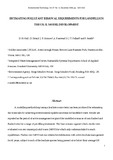JavaScript is disabled for your browser. Some features of this site may not work without it.
| dc.contributor.author | Hall, D. H. | - |
| dc.contributor.author | Drury, D. | - |
| dc.contributor.author | Gronow, Jan R. | - |
| dc.contributor.author | Rosevear, Alan | - |
| dc.contributor.author | Pollard, Simon J. T. | - |
| dc.contributor.author | Smith, Richard | - |
| dc.date.accessioned | 2011-09-29T17:24:12Z | |
| dc.date.available | 2011-09-29T17:24:12Z | |
| dc.date.issued | 2006-12-01T00:00:00Z | - |
| dc.identifier.citation | Hall, D.H.; Drury, D.; Gronow, J.R.; Rosevear, A.; Pollard, S.J.T.; Smith, R. Estimating Pollutant Removal Requirements for Landfills in the UK: II. Model Development, Environmental Technology, Vol 27, No 12, December 2006 , pp. 1323-1333 | - |
| dc.identifier.issn | 0959-3330 | - |
| dc.identifier.uri | http://dx.doi.org/10.1080/09593332708618754 | - |
| dc.identifier.uri | http://dspace.lib.cranfield.ac.uk/handle/1826/1737 | |
| dc.description.abstract | A modelling methodology using a leachate source term has been produced for estimating the timescales for achieving environmental equilibrium status for landfilled waste. Results are reported as the period of active management required for modelled scenarios of non-flushed and flushed sites for a range of pre-filling treatments. The base scenario against which results were evaluated was raw municipal solid waste (MSW) for which only cadmium failed to reach equilibrium. Flushed raw MSW met our criteria for stabilisation with active leachate management for 40 years, subject to each of the leachate species being present at or below their average UK concentrations. Stable non-reactive wastes, meeting EU waste acceptance criteria, fared badly in the non-flushed scenario, with only two species stabilising after a management period within 1000 years and the majority requiring >2000 years of active leachate management. The flushing scenarios showed only a marginal improvement, with arsenic still persisting beyond 2000 years management even with an additional 500 mm y−1 of infiltration. The stabilisation time for mechanically sorted organic residues (without flushing) was high, and even with flushing, arsenic and chromium appeared to remain a problem. Two mechanical biological treatment (MBT) scenarios were examined, with medium and high intensity composting. Both were subjected to the non-flushing and flushing scenarios. The non-flushing case of both options fell short of the basic requirements of achieving equilibrium within decades. The intense composting option with minimal flushing appeared to create a scenario where equilibrium could be achieved. For incinerator bottom ash (raw and subjected to various treatments), antimony, copper, chloride and sulphate were the main controls on achieving equilibrium, irrespective of treatment type. Flushing at higher flushing rates (500 mm y−1) failed to demonstrate a significant reduction in the management period requi | en_UK |
| dc.language.iso | en_UK | - |
| dc.publisher | Taylor & Francis | en_UK |
| dc.subject | Equilibrium | en_UK |
| dc.subject | Completion | en_UK |
| dc.subject | Emissions | en_UK |
| dc.subject | Municipal solid waste (MSW) | en_UK |
| dc.title | Estimating Pollutant Removal Requirements for Landfills in the UK: II. Model Development | en_UK |
| dc.type | Article | - |
Files in this item
This item appears in the following Collection(s)
-
Staff publications (SAS) [905]
